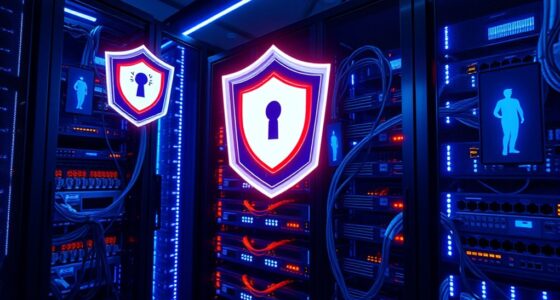Protecting your cable infrastructure from tampering and sabotage is essential to ensure operational integrity and security. Implementing physical barriers, secure access points, and tamper-evident labels can deter unauthorized interference. Incorporating sensor systems and intrusion detection tools adds an extra layer of security. But even with these measures, understanding how to effectively integrate them poses challenges that require careful planning and ongoing vigilance. Exploring these strategies further can make a significant difference in safeguarding your assets.
Key Takeaways
- Implement physical security measures like lockable enclosures, tamper-evident labels, and regular inspections to deter unauthorized access.
- Use advanced cable management systems with built-in sensors and environmental monitoring for real-time tamper detection.
- Educate staff on security protocols, tampering signs, and rapid response procedures to enhance vigilance.
- Establish and regularly update security policies that incorporate emerging threats and new tamper detection technologies.
- Install physical barriers and surveillance systems to discourage tampering and facilitate early detection of sabotage attempts.

Cable tampering poses a serious threat to network security and operational continuity, but you can prevent it with proactive measures. Ensuring robust cable security starts with understanding the vulnerabilities in your cabling infrastructure. Tamper detection is your first line of defense; it involves implementing systems that alert you immediately when unauthorized access or interference occurs. By focusing on tamper detection, you gain real-time insights into potential breaches, allowing you to respond quickly and minimize damage.
Proactive tamper detection safeguards your network by providing real-time alerts against unauthorized access.
Start by securing all access points to your cables. Use lockable enclosures, sealed junction boxes, and tamper-evident tape or labels. These physical barriers make it difficult for intruders to manipulate cables without leaving obvious signs of interference. Regular inspections are crucial—check for signs of tampering such as loose connections, broken seals, or damaged insulation. Incorporate tamper-evident features that trigger alarms or logs when disturbed. This way, you’re not only discouraging tampering but also equipped to detect it early.
In addition to physical security measures, leverage technological solutions for tamper detection. Many modern cable management systems come with built-in sensors that monitor cable integrity and alert you to any anomalies. For example, fiber optic cables can be equipped with monitoring tools that detect physical disturbances or changes in signal patterns. These tools continuously scan for irregularities, providing an extra layer of security. Consider installing intrusion detection systems that monitor environmental factors like vibration or temperature shifts, which often accompany tampering attempts.
Training your staff is equally important. Educate them on the importance of cable security and the signs of tampering. Make sure they understand how to recognize suspicious activity and how to respond swiftly. Establish clear protocols for reporting and investigating incidents, so that no time is wasted if tampering occurs. Remember, a well-trained team acts as an active line of defense, reinforcing your technical security measures.
Lastly, foster a culture of security awareness within your organization. Regularly review your cable security policies and update your tamper detection strategies as new threats emerge. Consistent vigilance, combined with advanced tamper detection tools and physical safeguards, creates an all-encompassing shield against cable tampering. Incorporating vetted security practices and staying informed about emerging threats ensures your network remains protected. With these proactive steps, you considerably reduce the risk of unauthorized access and safeguard your network’s integrity and operational stability.
Frequently Asked Questions
How Can I Detect Early Signs of Cable Tampering?
You can detect early signs of cable tampering through regular visual inspections for physical damage, unusual wear, or signs of interference. Additionally, guarantee tamper alarms are active and functioning properly; these alarms alert you to unauthorized access or disruptions. Pay close attention to any unexpected changes in cable performance or signals, which can also indicate tampering. Combining these methods helps you catch issues early and prevent further damage or security breaches.
Are There Specific Tools to Monitor Cable Security Remotely?
Yes, specialized tools for remote monitoring keep a close eye on your cables, alerting you instantly if suspicious activity occurs. Imagine a network of sensors and cameras silently watching over your infrastructure, their signals feeding into a centralized system. These advanced tools enable real-time detection, so you’re immediately notified of tampering attempts. With such technology, you gain peace of mind, knowing your cables are constantly protected and any threat is caught before harm happens.
What Are the Legal Implications of Cable Tampering?
If you tamper with cables, you face serious legal consequences, including fines and potential criminal charges. You could be held liable for damages, disruptions, or security breaches caused by your actions. Liability issues can also lead to lawsuits, affecting your reputation and finances. It’s essential to respect laws and regulations, as tampering can result in significant legal and financial repercussions that may impact you for years to come.
How Often Should Cable Security Inspections Be Conducted?
Think of cable security inspections like a heartbeat—constant and essential. You should conduct inspections at least quarterly, but the frequency depends on your risk assessment. Higher-risk areas require more frequent checks, maybe monthly, to catch tampering early. Regular inspections help you stay one step ahead, ensuring your cables remain secure and minimizing potential sabotage. Don’t wait for trouble; proactive monitoring keeps your system safe and reliable.
Can Environmental Factors Affect Cable Tampering Vulnerability?
Environmental hazards and physical interference can definitely increase your cable tampering vulnerability. Harsh weather, such as storms or extreme temperatures, can weaken cable insulation or cause damage that makes tampering easier. Additionally, physical interference from falling debris or vandalism can expose cables, making them accessible to tampering. Regular inspections and protective measures help you mitigate these risks, ensuring your cables stay secure despite environmental challenges.
Conclusion
By implementing physical barriers, sensor systems, and staff training, you substantially reduce the risk of cable tampering. Did you know that organizations with robust security measures see up to a 70% decrease in sabotage incidents? Staying proactive and vigilant not only protects your infrastructure but also saves you from costly disruptions. Remember, combining technology with awareness is your best defense—stay alert, stay secure.









